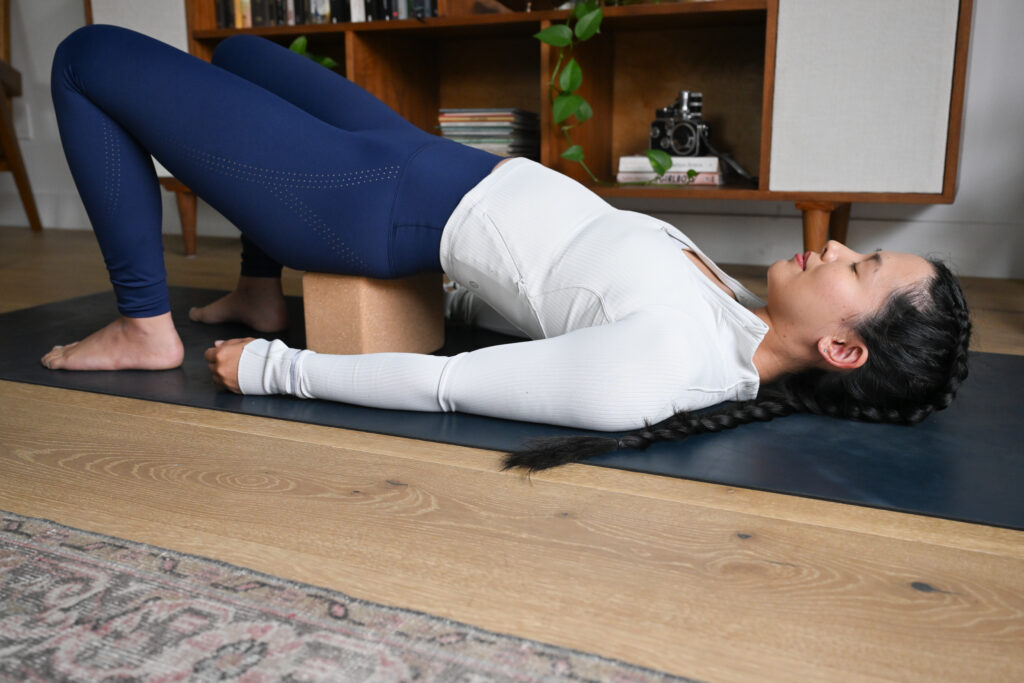Yoga for a Healthy Back: Strengthen Your Spine and Relieve Tension

It’s a tale as old as time: you go to the doctor with back pain, and they suggest taking a yoga class. So you show up at your neighborhood hot yoga studio, take some classes, and realize yoga means a LOT of different things. So, what the heck are we talking about when people suggest yoga for a healthier spine? What kind of yoga? Does it have to be 100 degrees? Should I be folding into a pretzel?
Before we answer the question about whether folding into a pretzel is the secret to pain- free living, let’s zoom out for a second and talk about the relationship between yoga and feeling good in your body. Yoga, with its holistic approach to fitness and well-being, can significantly benefit your overall sense of well-being, physically and mentally. Not only does it offer a balanced combination of strengthening, stretching, and relaxation techniques, it does so through the lens of mindfulness. By paying attention to sensation and breath (instead of mindlessly going through reps), there is an opportunity to develop a deeper awareness of your body and, in turn, help your body (and spine!) feel resilient, strong, and supple.
Yeah, yeah, okay, you buy it, so let’s get to the facts.
How Yoga is Good for Your Back:
- It strengthens it! One of the primary benefits of yoga is that it strengthens the muscles that support your spine. Poses like the Plank, Cobra, and Bridge Pose engage the back muscles, helping to build a strong foundation for your spine. A stronger spine means less injury risk and more time doing the things you love.
- Yoga improves mobility. Yoga enhances your spine’s mobility, allowing it to move in a more natural and unrestricted way. This can help alleviate stiffness and reduce the risk of chronic pain in the long run.
- It improves awareness of your body and spine. Yoga promotes better posture by increasing body awareness and helping you develop the core strength needed to maintain an upright position. So if you sit a lot (drive, work at a desk, couch surf, you know…), having the awareness to shift and change position is a game changer.
What Poses You Can Incorporate for a Strong Spine:
- Bridge Pose (Setu Bandhasana): The Bridge Pose is a classic yoga pose that targets the spine and surrounding muscles. To perform this pose, lie on your back with your knees bent and feet hip-width apart. Slowly lift your hips, rolling your spine off the ground while keeping your feet and shoulders firmly rooted. This builds awareness of your spine, strengthens the stabilizers, and improves general mobility and strength of the backside of your body.
- Child’s Pose (Balasana): This resting pose gently stretches the spine and helps release tension in the lower back. Kneel on the floor, sit back on your heels, and extend your arms forward. Rest your forehead on the mat, and breathe deeply to relax and elongate the spine. You can also lie on your back and hug your knees if weight-bearing on your knees is a no-go.
- Cat/Cow (Marjaryasana/Bitilasana): This dynamic combination of poses involves arching and rounding your back while transitioning between a cat-like and cow-like posture. It’s excellent for enhancing the flexibility and mobility of the spine. Try adding circles in the shoulders and hips, side-to-side movements, and anything else that feels good!
Should You Do Yoga for Back Pain?
We’ve discussed how yoga is helpful for a strong, healthy spine, but what should you do if you’re currently experiencing back pain? While yoga CAN be beneficial for back pain, it’s essential to follow these guidelines:
- Consult a Healthcare Professional: If you have a history of severe back pain or any underlying medical condition, consult a healthcare professional or physical therapist before starting a yoga practice.
- Choose the Right Yoga Class: Opt for a gentle or therapeutic yoga class if you’re new to yoga or have back issues. These classes are designed to cater to individuals with physical limitations. Or, consider working with a private yoga teacher specializing in therapeutic yoga.
- Listen to Your Body: Always listen to your body during your practice. If a pose causes discomfort or pain, modify or skip it altogether. Yoga should be about healing, not pushing yourself to the brink of injury. Remember: You don’t have to be flexible to start.
- Consistency is Key: Regular practice is vital for reaping the full benefits of yoga. Over time, you’ll notice improvements in your back’s strength, flexibility, and overall health.
Yoga is a beautiful tool for maintaining a healthy back, preventing pain, and improving posture. Through its combination of strength, flexibility, and mindfulness, it addresses the root causes of back issues rather than just masking the symptoms. By incorporating yoga into your daily routine, you can enjoy a healthier, happier back and embrace a pain- free, well-aligned spine for years, with no pretzel-folding needed.
I think Pilates is good for a Healthy Back, because Pilates focuses on core strength, flexibility, and posture, promoting a healthy back. With targeted exercises and mindful movement, it provides a holistic approach to spinal health, preventing discomfort and fostering overall well-being.